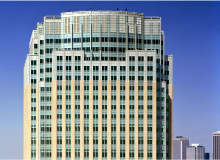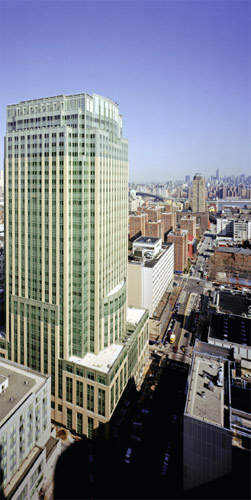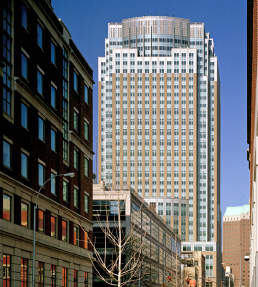Brooklyn Supreme and Family Courthouse is an important element in New York’s courthouse renovation and construction. Jonathan Stark, principal and director of Perkins Eastman, outlines the complexities of designing a classically imposing structure that is also a state-of-the-art office building.
At 32 storeys and 473ft high, totalling more than 1.1 million ft², the Brooklyn Supreme and Family Courthouse at 330 Jay Street is New York State’s largest and most programmatically complex courthouse and office building.
It is home to the New York State Supreme Court, with 50 courtrooms; the Kings County Family Court, with 34 courtrooms and hearing rooms; and a number of state and city agencies.
The building also includes a 750-person jury suite, a 250-person detention facility, support spaces for the courts’ administrative functions and 150,000ft² of speculative office space.
The project represents more than 10 years of development, design and construction, and has become a major addition to the landscape and the local economy of downtown Brooklyn.
Selecting the site
In support of the New York State Office of Court Administration’s initiative to move towards a unified court system, the decision was made to move the Supreme and Family Courts to a single location in Brooklyn. This will allow judges to oversee multiple types of cases and increase the overall efficiency of the two courts.
A multi-year effort to find a suitable location for the new courthouse was conducted throughout the Brooklyn downtown area. This resulted in the selection of a site controlled by Forest City Ratner Companies, the prominent developer of the MetroTech Center in Brooklyn.
The site is in close proximity to the downtown Brooklyn Civic Center and is easily accessible by public transportation.
The modern courthouse
Philosophically and architecturally, the courthouse traces its roots back to ancient Greece and Rome. To this day, the word ‘courthouse’ evokes images of classical architecture, precisely because many of those early public buildings were designed to reflect the order and harmony of the young US nation.
The modern courthouse, however, is in a period of transition. It is no longer limited to heavy stone and columns, and now aspires to be a less foreboding, more user-friendly environment.
Nevertheless, the design must still convey the dignity of the judicial system, providing a sense of ceremony from the approach to the courthouse to the corridors leading into the courtroom.
The modern courthouse should demonstrate an appreciation of detail and of how the language of civic architecture has evolved. It must also incorporate technological advancements designed to expedite the judicial process and tighten security.
The design should be influenced by its surroundings, present a positive image of the government, and create a space that is user-friendly, open and accessible. It should aim to be well regarded by the wider community and refrain from any inappropriate aesthetic flourishes.
The ideal courthouse is, above all, a rational building, epitomising good judgment and perfect harmony with its immediate environment.
An opportunity for the city
Although the site was originally earmarked for an office building, the developer offered the City of New York the chance to become the primary tenant.
The site’s location near the existing Supreme Court, Family Court and Government Center, its size – sufficient to house both courts and related government agencies in one building – and the opportunity for the city to lease the building and avoid a lengthy and complicated procurement process made it the ideal new home for the Brooklyn Supreme and Family Courts.
Ultimately, the project was developed as a turnkey public / private partnership between the City of New York and Forest City Ratner Companies. The site did come with some complications.
To allow for the development of over a million ft² of space on the site, the developer and an adjacent hotel entered into a Zoning Lot Development Agreement (ZLDA), which stipulated the maximum height of the new building (473ft), as well as numerous setbacks for the building and sight lines that could not be obstructed.
This helped create a fixed, tight envelope which Perkins Eastman had to adhere to when designing this state-of- the-art courthouse.
Design challenges
Designing a major new courthouse in a busy urban environment such as downtown Brooklyn presented special challenges:
- Addressing neighbourhood concerns: in an urban environment, there is little space between buildings, so issues of traffic and queuing space (for both vehicles and pedestrians), bus routes and parking had to be addressed.
- Pedestrian movement: the Brooklyn Supreme and Family Courthouse handles a very high volume of cases, requiring particular attention to pedestrian movement into and within the building.
- Verticality: the smaller lot sizes of urban environments meant combining two courts into a vertical building and dealing with all of the additional complexities of planning functional and efficient spaces and circulation systems.
- Security: the smaller urban site made achieving an adequate building stand-off more difficult. Blast protection, ballistic protection and electronic security were all very complex, but also very important. The design team needed to address these requirements without creating an intimidating, fortress-like structure.
- Secure parking and prisoner access: the sally ports and parking for judges required a considerable amount of space, which was best accommodated on below grade floors of the building. Prisoner bus access also had to be secure without impinging on the surrounding neighbourhood.
- Natural light: in any place of work, employees value natural light. The challenge for the Brooklyn Supreme and Family Courthouse was to provide natural light in secure zones of the building while obscuring judges’ movements from surrounding buildings.
Working with a tight envelope
Given the tight envelope and the predetermined building mass, the design team concerned itself primarily with laying out a modern court floor plate that was functional, efficient and easy to navigate by all occupants of the building. This gave rise to a number of design challenges involving the building’s exterior.
Influenced by the local context of the MetroTech office complex and surrounding residential districts, the façade combines elements of brick, glass and stone into a traditionally inspired piece of courthouse architecture, which also satisfies the developer’s requirement for a state-of-the-art modern office building.
Brick, a common building material in Brooklyn, gives the building a feeling of solidity, while vision and spandrel glass windows suggest the façades of modern steel and glass office buildings.
The verticality of the façade, highlighted by the brick, serves multiple purposes. Stylistically, it makes subtle reference to the columns of a traditional courthouse. The vertical expression also brings order to the many different floor-to-floor heights visible on the façade.
Supreme courts, which have a larger footprint, require higher ceilings than family courts, and those floors with courts are generally taller than floors that contain offices alone.
These vertical lines also take advantage of the building’s shape, as determined by the sightline preservation requirements. Corners by the setback of the tower and the building’s curved torso create a harmonious whole, with the vertical lines guiding the eye in a single direction.
The programmatic challenge
Perkins Eastman approached the design as a means of reviving the failing image of the city’s courts, as well as addressing its physical inadequacies.
Combining 84 courtrooms and ancillary spaces for two court systems with 150,000ft² of office space into an existing envelope required more than the usual amount of programming and planning expertise.
Each of these uses – the Supreme Court, Family Court and the commercial office space – had such specific needs that it made more sense to use a building-within-building layout.
Each is accessible only from the ground floor, and has its own circulation system, lobby and entrance. The building’s layout is further broken down so that the Supreme and Family Courts can provide circulation paths for judges, public visitors and prisoners.
Judges take special access-restricted elevators to their chambers, courtrooms and dedicated parking, while the public takes elevators located right off the main spine of each floor, leading to the courtrooms and State and City agencies.
This reinforces the idea of the procession; the clear delineation of spaces as one moves from the lobby through to the courtrooms themselves. Prisoners take elevators located at their arrival points, which lead directly to holding areas assigned for every two courts.
Catering to individual agencies
The commercial office spaces are located on the uppermost floors of the building, occupying the 26th-30th floors.
The rest of the building, however, is devoted to the courts and more than a dozen City agencies, including: the New York City Corporation Counsel; the New York Police Department; the New York City Department of Corrections; the New York City Administration for Children’s Services; the New York City Department of Juvenile Justice; the New York State Office of Children and Family Services; the Kings County District Attorney; Victim Services / Safe Horizons; Legal Aid and The New York State Office of Mental Health.
The design team worked with representatives of the courts and each City agency to determine space needs, functionality requirements, adjacency requirements, paper flow and work conditions in order to develop innovative planning solutions both within and among the agencies.
Determining the appropriate locations of the agencies involved a lengthy process of consensus building, as each agency had its own agenda and requirements.
In many cases, each of the agencies became separate design projects in their own right. Ultimately, the individual requirements of each agency and the courts had to result in a harmonious layout and circulation patterns that were simple and intuitive for employees and visitors alike.
Strengthened security
Building security, both structural and electronic, is a major concern for any new building in New York.
For the Brooklyn Supreme and Family Courthouse, the design team incorporated advanced physical and electronic security throughout the building. The structure system was designed to resist a car bomb and to protect against progressive collapse of the columns.
The slab between office floors and court occupancy is hardened for blast protection, as is the truck dock on the commercial lobby level and the separation between court and commercial spaces.
The windows are a composite material of laminated and tempered glass, with blast-resistant frames. The curtain wall at the judges’ chamber floors conforms to UL Level III anti-ballistic construction, while the blast protection measures used in the building meet GSA modified level C blast requirements.
Specific criteria were developed through a Threat Analysis and Risk Assessment (TARA) in cooperation with the courts, the Department of Corrections and the NYPD.
Bollards placed around the building provide protection from vehicular threats. Exterior columns and all interior columns in public lobbies are jacketed in concrete for protection from hand-held explosive devices.
Public lobbies, loading docks and vehicular entry areas have blast-strengthened walls and slabs. In addition to the structural enhancements, sophisticated electronic security has been incorporated throughout the building. In fact, the building contains more than 4,500 units of the most advanced electronic security equipment.
Courtroom and community
The design team addressed community concerns regarding quality of life and neighbourhood security issues, believing these to be an equally important part of the project. These concerns include increased traffic in and around the area, as well as queues of buses and visitors outside the building.
The design team performed numerous studies and came up with the solution of constructing a full-floor sally port in the first level basement, along with parking areas and stacking and queuing areas for buses, to avoid having to park on the street with prisoners.
A cellblock for 250 prisoners permits a reduction in the number of trips the buses make in and out of the building due to court scheduling. In addition, a number of courtrooms are wired for video arrangements and motions, making it unnecessary for some prisoners to go to court at all.
The large lobby not only gave the courthouse the requisite sense of scale, it also allowed visitors that typically queue inside and outside the courts to remain fully indoors rather than standing outside the building.
A separate study to determine how quickly people could go through the magnetometer allowed the design team to ascertain the number of magnetometers needed at any given time to accommodate pedestrian traffic through the lobby area.
Contractors
The structural engineer was Gilsamz Murray Stefick and the general contractor was Turner Construction. The steel structures of the building were erected by DCM Erectors and the other steel parts and frames was erected and created by Empire City Iron Works.
The ornamented steel frames were created and erected by A-Val Architectural and Metal Corp. The aluminium curtain wall was placed by Enclos Corp. and the metal deck was erected by a joint attempt of the Solera and DCM Erectors.










